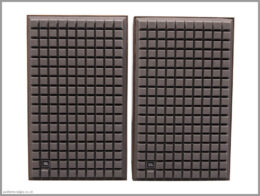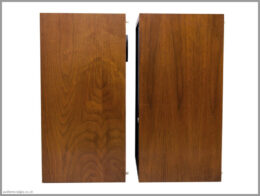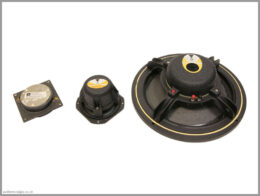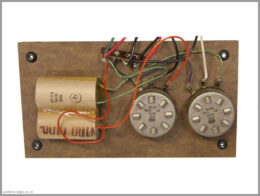TABLE OF CONTENTS
MY STORY
After experiencing JBL L26, I really wanted to get my hands on JBL L100 to see what they are all about. I patiently waited for a year, and eventually, a set came up on eBay – 2h drive from where I live. I made an offer and couple of days later I became an owner of a set of legendary JBL L100A.
As expected from 40 years old second hand speakers, they had normal wear and tear marks on the cabinets, slightly pushed in tweeter dust caps and crackling potentiometers – nothing that would put me off from buying them.
Please note – usually before reviewing vintage speakers, I recap the crossovers to ensure that capacitors are within manufacturer’s specification. On this occasion, I recapped the crossovers with basic polypropylene capacitors, as the original ones where slightly out of their tolerances. I also replaced the crackling attenuators with like-for-like l-pads. The internal wires were replaced with basic OFC cables. More details about these upgrades can be found in the upgrades section. Speakers in their original condition, were unlistenable, mainly due to the poor connection at the l-pads, which caused distorted sound. This means that my subjective views below refer to the sound that could be achieved with these speakers, with a bit of work. You will not get the same sound if you buy them and leave them in ‘original’, out of spec condition. Moreover, bear in mind that purchasing vintage speakers is always a gamble. 30 and often 50 years it’s a long time, and one can never be sure how this time affected the loudspeaker drivers. Consequently, it is possible that the JBL L100 Century that you have purchased will measure and sound different than the pair I reviewed.
SPEAKER INFO
Model History
The JBL L100 Century are the consumer version of the legendary JBL 4310 studio monitors. In the late 60s, JBL already had a great reputation for making very accurate, full size monitors for studios. Growing demand for more compact control room monitor, forced JBL to start working on the 4310 model. The requirements were: high power handling, high acoustic output without distortion and smooth frequency response thought entire audio spectrum – all of that from a 45l enclosure. Two years after the work begun, JBL Professional Division introduced the 4310 studio monitors. These speakers quickly became first choice for many well known studios, including Capitol, Deutsche Grammophon, EMI, London/Decca, RCA, etc. In fact, these monitors became so popular, that many musicians and engineers started purchasing these for home use. This in turn, encouraged JBL to produce the consumer version of these monitors – JBL L100. JBL claimed for these to be acoustically identical to the studio equivalents, but finished in more provocative style, appropriate for home environment. And this provocative style is one of the most recognisable features of the JBL L100 speakers – the open cell foam grilles with truncated pyramids. I dare to say that these are one of the most iconic speak grills ever made.
There are different version of both studio monitors as well as consumer speakers:
- 4310 – fist set of studio monitors featuring distinctive oval baffle for medium and high frequency units. Drivers HF: LE20, MF: LE5-2 LF: 123A-1.
- L100 – consumer version of the above studio monitor featuring all transducers in the centre line of front baffle. Drivers HF: LE20, MF: LE5-2 LF: 123A-1.
- 4311 – upgraded version of studio monitors, now featuring all drivers closer to each other on a reassessed baffle to accommodate flush fitting fabric grille. Drivers HF: LE25, MF: LE5-2 LF: 2213.
- L100A – consumer version of the above studio monitor featuring non-linear drivers layout. Drivers HF: LE25, MF: LE5-2 LF: 123A-1.
Design
The version I am reviewing is the L100A. So what do we have here? Well, these are relatively large by modern standards, 3 way bookshelf speakers with a very basic crossover network and all driver diaphragms made of paper. What a mixture!
JBL L100 CENTURY SPECS
| Frequency Response: | Unknown |
| Sensitivity: | 91dB (1W input, measured at 1m) |
| Impedance: | 8Ω |
| Power Capacity: | 50W (continuous program) |
| High Frequency Driver: | LE25 36mm (1.4″) Paper Diaphragm |
| Medium Frequency Driver: | LE5-2 130mm (5″) Paper Diaphragm |
| Low Frequency Driver: | 123A-1 300m (12″) Pressed Paper Diaphragm |
| Crossover Frequencies: | 1,500Hz and 6,000Hz |
| Enclosure Type: | Bass Reflex |
| Enclosure Dimensions (HxWxD): | 600x360x350mm (23.5×14.5×13.75″) |
| Weight: | 24kg (each speaker) |
| Production Year: | 1974 |
| Price When Launched: | £235 for a pair |
| Equivalent Present Day Price: | £2,560 for a pair |
| Current UK Price: | £300 to £900 for a pair |
Look & Feel of JBL L100 Century Speakers
These JBLs are a little like Marmite – you either like them or you don’t. I personally like them a lot! There is something very appealing about the large white diaphragm and non linear drivers layout – studio heritage perhaps?
The finishing quality of the drivers and attention to details is astonishing. Even these days, we rarely see drivers so well made. Not to mention 40 years ago, especially if we compare and contrast these with British speakers from that era. Bass and midrange units are powered by large Alnico V magnets, whereas tweeters are energised by respectable size ferrite magnets. Baskets of the bass and treble drivers are made from a black powder coated aluminium. All diaphragms are made of paper… yes, even tweeters – which is not something that we come across in modern speakers.
The original crossovers are probably the weakest link of these speakers. They consist of two high-pass filters (two electrolytic capacitors) – one for midrange and one for tweeter, as well as two l-pads that allow you to attenuate treble and midrange output. The potentiometers are made by Alps, and look like quality units, however, if you are planning to use the speakers with original crossovers, the l-pads will need to be cleaned or replaced. I was a little surprised to see so beautifully made drivers accompanied by such a crude crossovers.
Cabinets are made of 18mm chipboard, finished in oiled walnut veneer, without any internal bracing. They are fairly rigid but we can do much better nowadays. The grilles… well, the original grilles are very unique but the open cell foam tends to deteriorate with time, hence, you would have to be very lucky to find original, pyramid shaped foam grilles. There are companies that make replicas of these grilles, but they cost a fortune.
SOUND OF JBL L100
First Impressions
A lot of music that I listen to is folky and acoustic stuff, without very complicated passages. When I plugged these JBL L100 for the first time, the thing that struck me was how natural and realistic the voices sounded when compared with my Yamaha NS1000. I could not believe how much more realistic Bob Dylan’s voice sounded on Girl From the Country North. The sound was not necessary more clear, if anything it was more rough, but there was something very appealing about it. It was like the singer was singing in a different tonality. If I was to use a metaphor, the Yamaha NS1000 sounded digital, whereas JBL L100 sounded analogue. Not as refined but very engaging. However, what benefited Bob Dylan’s voice, did not benefit Eric Bibb’s voice on tracks such as Braggin’, which sounded much more natural on the NS1000.
Bass
The bass is definitely a strength of the JBL L100. I was really surprised how realistic drums sound on these speakers. Probably one of the most realistic presentation I’ve heard so far. And it is not even the good attack, it is more the tone of it and the illusion that the drums are being played in front of you. Bass is nice and punchy but it roles off quickly below 40Hz. However, you rarely miss it, unless you know is should be there.
Midrange, Treble, and Soundstage
Whenever I test any speakers, I always start with tracks that allow me to isolate sounds. I.e. I use recordings with drums only, with guitars only, with a cappella singing, etc. Then I jump to more complex tracks. This process allows me to identify with greater confidence how the speakers reproduce given instruments/sounds in isolation and then as a part of more complex music passages. And the JBL L100 are quite good at playing different sounds in isolation. The vocals are very special, songs such as Spanish Harlem by Rebecca Pidgeon sound sublime. Clapping sounds very realistic too. The string instruments sound very good and I could not really find anything negative about wind instruments either.
However, when it comes to more complicated music passages, performance of the JBL L100 seem to be totally depended on the music choice. Some tracks suit JBLs whereas others don’t. Moreover, with songs containing full frequency spectrum, you also start noticing lack of balance, especially when you compare them with more linear speakers. JBL L100 seem to be rather hot at the top, and overtime this can become fatiguing. If you spend long time listening to music, they may not be the best speakers for that. However, for short listening session, they definitely put a smile on your face. Some really well recorded tracks seem to go better with very refined and analytical sound on Yamaha NS1000, whereas others seem to suit the less refined style of JBL L100.
Soundstage
In terms of soundstage, the JBL L100 seem to play everything from the speaker line, with the vocals being pushed in front of the speakers, so they do not give an impression of a deep soundstage. Stereo presentation is fine, however, the speakers do not ‘disappear’ from the room. Your are conscious that the sound is coming from the speakers. It may be because of the bass driver doing so much midrange, and therefore, having really large radiating area generating midrange. This brings us to the subject of positioning these speakers. They are much better lifted off the floor at least 50cm, so the bass driver is closer to the height of your ears.
Overall, very impressive classic loudspeakers. They may not be the most balanced or refined speakers but they are an important part of audio history, and I like them for that.
CONCLUSION
Surprisingly natural presenters in terms of voices and drums. Can sound very good at lower listening levels with relatively simple music or make your ears bleed at higher volumes with more complex music passages. Too fatiguing for long listening sessions, but definitely put a smile on your face.
| Balance of Sound: | |
| Neutrality of Tone: | |
| Transparency: | |
| Soundstage: | |
| Attack: | |
| Engagement: | |
| Total Score: |
SONGS MENTIONED IN THIS REVIEW
Bob Dylan – Girl From the Country North
Eric Bibb -Braggin’
Rebecca Pidgeon – Spanish Harlem
Reviewed: April 2017 | Published: July 2017













